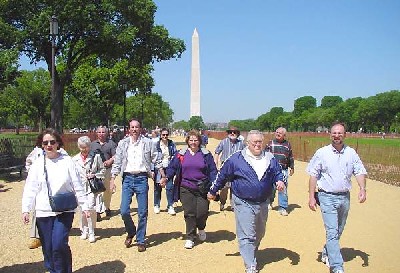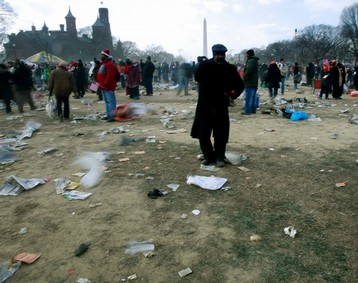Marketing the local experience that is also DC

People visiting "Washington." (Original photo source unknown.)
I have written about this a lot over the years, this is putting together some of my responses to a thread about the topic on the HistoricWashington e-list, with the added benefit of some post-sending editing.
The biggest problem with "selling" DC history is that the entire world interprets "local DC history" through the lens of the story of the founding and continued management of the United States of America.
And don't under consider the issue of charging admission in a city where the majority of the most in demand destinations are free. It's not like the Phillips Collection and the Corcoran Museum of Art, which need to charge admission as a part of their revenue generation model, thrive vis-a-vis the National Gallery of Art and the Smithsonian art museums, which do not charge admission fees. (See "Museum negotiates masterpiece of a deal" from the Washington Business Journal, about the Phillips Collection.)
Note also that while the International Spy Museum (a for profit entity) has thrived, despite having to charge admission, the Madame Tussaud's Wax Museum has not.
So developing the local narrative, packaging it, and selling it becomes a "Market Development" (look up the term in the marketing literature) problem of almost immeasurable difficulty.
The people who visit DC come here to go to the Smithsonian Museums, the U.S. Capitol, the White House, the Washington Monument, maybe Mount Vernon (are you familiar with the complete reworking of the exhibits/narrative there over the last couple years), as well as a visit to either or both Alexandria and Georgetown to combine both seeing "old" buildings as well as shopping and entertainment.
While the Destination DC (the local CVB) campaign "Power Play" does market, some, local destinations, the campaign is more focused on the national narrative more than the local. (And these days with the economic downturn, Destination DC has problems too. See "Destination D.C. lays off 12 employees," from Washington Business Journal.)
While it is true that the "cultural tourist" stays longer and spends more compared to non-cultural tourists according to all of the research, "cultural tourists" come to DC to consume a significantly different "non-local" but place-based experience compared to the typical cultural tourist visiting other places
Besides, depending on the tranche of tourist demographics, many stay outside of the city because of the high room rates at hotels/motels based in the city. That is a big issue with National Harbor, the soon-to-be-location of a Disney Hotel (see "Walt Disney to build at National Harbor" from the Washington Business Journal) and local tourism marketing campaigns from other jurisdictions, i.e., Montgomery County Maryland's "DC Days, Montgomery Nights" (mean visit DC during the day but stay in Montgomery County) campaign of a few years back.
To consume a portion of the local story (visit some neighborhoods, walk a history trail, go to a local history museum) visitors will need to stay at least one additional day, which means at least one more rooming night, andspending more money. (Plus let's face it, if you are visiting here with children, going to see decidedly local attractions might be a stretch.)
You mention local corporate support. The DC region has real estate developers (and their support staff--law firms, financiers, and parking magnates in the city) and military contractors primarily. The city is full of nonprofit organizations (trade associations, advocacy groups, universities). The federal government is not a donor organization either.
In short, there is limited support and limited recognition of the value of "DC" as opposed to being in DC to be proximate to the federal government. This makes it doubly difficult to promote a local narrative through a local history museum. To get a better sense of the local business establishment I always recommend the urban sociology article "The City as a Growth Machine." Promoting local history if it can't be adequately monetized isn't high on their agenda.
Then there is the issue of tourism taxes (hotel tax, car rental tax, some portion of restaurant meals taxes). Most go to pay off the convention center. Upwards of $10 million goes to Destination DC, the organization tasked with marketing the city as a place to visit.
Very little goes to fund the development and presentation of local history and cultural assets. (This is discussed in my paper on cultural heritage and assets.) And the while Convention Center supports local hotels and restaurants, although most of the hotels do not have local owners, I do question whether or not the fact that the Convention Center consumes the bulk of the local tourism tax revenue stream is the best use of the money.
The primary reason I advocate for separating out a tourism development and management element within the DC Comprehensive Land Use Plan is to reorient how the city develops, manages, markets, and funds cultural assets.
And speaking of the federal government, specifically the 435 members of the House of Representatives and the 100 Senators. They don't care about DC either. They are in DC because DC is the home of the national government, but they are not of DC.
Since so many of them position their image/role as being "against DC/running against Washington," the last thing you're going to do is see them throw off their yoke of parochialism and focus on what we might call meta-national issues, one of which would be putting resources into the National Capital (buildings, monuments, parks, transportation infrastructure, cultural assets) so that it shines and communicates a great message about "America" (the United States) as a nation that also cares about its cultural as sets and the way it is displayed to the world.
See for a contrast this 1992 NY Times Magazine article about Paris, "Why Paris Works." From the article:
FOR MANY OF THE CITY'S 2.2 million residents and many of the 20 million tourists who visit each year, Paris remains a magical, even transcendent, place. While many Americans shun their own cities as if they were places suffering from the plague, Paris is a city with which countless people still have a passionate love affair.
The people who run Paris know that if their city relied on just the charms of its past, it would lose its magic. Thus, they have sought to superimpose a smoothly running, modern metropolis on the city bequeathed them by medieval kings and 18th-century revolutionaries. And they have succeeded royally.
Garbage is picked up seven days a week, mail is delivered three times a day and all of Paris's 800 miles of streets are swept by hand each day. At rush hour, the subways come once every 80 seconds, and many Metro stops are decorated with mosaics and murals. Affluent families are rushing not to flee for the suburbs, but to buy apartments in Paris's choicest neighborhoods and to send their children to public schools.
There is no single explanation for why Paris works so well. Rather, Paris has become a shining model for urban planners thanks to numerous ingredients lacking in many other cities: ample financing, sound administration, farsighted planning, technological ingenuity, a flair for design and an ambition to always improve.
France puts more federal money than the norm into Paris because Paris is the national capital and because it defines France and how France is "consumed" when it is visited. AND because how France and Paris looks to others matters to people in France, particularly members of the government, but also to many French citizens whether or not they live in Paris.Congress will spend money on itself--the underground National Visitors Center at the U.S. Capitol cost over $500 million to build. (Note that in the first year, not yet over, the NVC at the Capitol has received over 2 million visitors.) But Congress is less inclined to put money into other parts of the city to improve the quality of the experience. They don't think much about the "nation" and how it is perceived. They do think a lot about their districts and how to get reelected.
I meant to blog about the new "tax," or $10 fee on international visitors. (See the AP story, via the Seattle Times, "Industry pushes new international visitor fee.")
The fee is supposed to fund marketing the U.S. to international tourism markets. Most national governments in other countries have extensive marketing and tourism programs. In fact, I regularly use development materials that are produced by tourism departments from Canada, the United Kingdom, and Australia, because the materials are so good. (Actually in the U.S., most states are quite good at tourism development and marketing, even if I complain about DC's efforts in this area. While not perfect in every respect, both Maryland and Virginia are well respected for their tourism development and marketing programs.)
This fee has been opposed by some quarters, but is in some respects a desperate move to raise money for something that is necessary, but is impossible to get Congress to appropriate money for otherwise.

WASHINGTON, D.C. - JANUARY 20: A man walks past trash after the inauguration of Barack Obama as the 44th President of the United States of America on the National Mall January 20, 2009 in Washington, DC. Obama becomes the first African-American to be elected to the office of President in the history of the United States. (Photo by Mario Tama/Getty Images)
See the AP story, "Neglected National Mall languishes," which reports on how Members of Congress write earmarks for national parks and other cultural institutions in their own states, while voting against appropriations for improvements to the National Mall, which connects the U.S. Capitol, the Washington Monument, and the White House, and is visited by tens of millions of people each year.
From the article:
The mall didn't just lose out on earmarks. In January, Congress deleted $200 million in stimulus funding for the mall. And last year, a bill that would have appropriated $100 million for mall repairs failed.
Republican Rep. Jeb Hensarling of Texas said mall funding wasn't an emergency.
"It's entirely appropriate for Congress to fund repairs for the National Mall in the traditional process, but the American people are smart enough to know that it will do very little or absolutely nothing to provide economic stimulus," he said.
House Republican whip Eric Cantor of Virginia similarly derided efforts to "help upkeep the grass on the lawns of Washington."
Yet Congress invests in sod and flower beds on its own grounds at the Capitol, which are kept carefully manicured, even as the mall — which runs 2 miles from the Capitol to the Lincoln Memorial — has languished.
Congress employs about 1,900 workers to maintain its buildings and 450 acres, while the National Park Service has about 200 maintenance workers for the 650-acre mall and memorials.
To deal with all the very difficult issues recounted above you need more than a blog, you need to have people who are really really good, and very much focused on developing and extending the quality of locally based and significant cultural heritage.My joke about DC is that the big government (the federal government) trickles down and shapes little government (the local municipal government) and civil society in its image.
So you can imagine we also have a vision and personnel problem too.
Labels: arts-culture, cultural heritage/tourism, cultural planning, historic preservation, public finance and spending, taxation, Washington history



0 Comments:
Post a Comment
<< Home